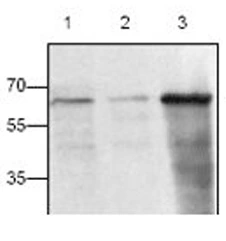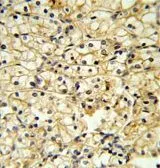CD40L / CD154 antibody
GTX10507
ApplicationsFlow Cytometry, Western Blot
Product group Antibodies
TargetCD40LG
Overview
- SupplierGeneTex
- Product NameCD40L / CD154 antibody
- Delivery Days Customer9
- Application Supplier NoteWB: 1 microg/ml. *Optimal dilutions/concentrations should be determined by the researcher.Not tested in other applications.
- ApplicationsFlow Cytometry, Western Blot
- CertificationResearch Use Only
- ClonalityPolyclonal
- ConjugateUnconjugated
- Gene ID959
- Target nameCD40LG
- Target descriptionCD40 ligand
- Target synonymsCD154, CD40L, HIGM1, IGM, IMD3, T-BAM, TNFSF5, TRAP, gp39, hCD40L, CD40 ligand, CD40 antigen ligand, CD40-L, T-B cell-activating molecule, T-cell antigen Gp39, TNF-related activation protein, tumor necrosis factor (ligand) superfamily member 5
- HostGoat
- IsotypeIgG
- Protein IDP29965
- Protein NameCD40 ligand
- Scientific DescriptionCD40 ligand (also known as CD154, TRAP, or gp39) is a 261 amino acid type II transmembrane glycoprotein belonging to the tumor necrosis factor (TNF) superfamily. CD40L is expressed predominantly on activated CD4+ T lymphocytes. It is also found in other cell types (NK cells, mast cells, basophils, and eosinophils). Human and mouse CD40L share approximately 78% sequence identity. The receptor for CD40L is CD40. CD40, a type I transmembrane glycoprotein belonging to the TNF receptor family, is expressed on B lymphocytes, monocytes, dendritic cells, and thymic epithelium. Following interaction with CD40 ligand, CD40 mediates a number of major immunoregulatory functions central to the control of thymus-dependent humoral immunity and may be critical in the development of cell-mediated immune responses. Other biological actions include B cell homotypic adhesion, proliferation, immunoglobulin isotype switch, and secretion. The interaction of CD40 and CD40L also plays important roles in monocyte activation and dendritic cell maturation. Activation of CD40 inhibits the growth of certain B cell lymphomas and induces the death of transformed cells of mesenchymal or epithelial origin.
- Storage Instruction-20°C or -80°C,2°C to 8°C
- UNSPSC12352203


![FACS analysis of IgE-activated human peripheral blood using GTX00579-06 CD40L / CD154 antibody [24-31] (FITC). Orange : blank Blue : CD154 negative cells Red : CD154 positive cells](https://www.genetex.com/upload/website/prouct_img/normal/GTX00579-06/GTX00579-06_20191028_FACS_1_w_23053121_728.webp)
